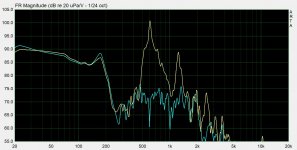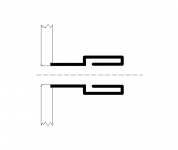Hello to all,
After several trials I built a vent that successfully kills pipe resonances. It's a simple pvc drain tube fitted with two closed traps of the same diameter stuffed with polyster fibers. Dimensions in the photo/drawing. I made the vent very long to enhance resonances spl. The second trap was necessary to kill the H2 at 1230Hz. BTW, I built also a vent with some holes in its middle and the result is OK, but not as efficient as the double trap system, mainly on the H2.
Placement of the traps: the longer one has to be the further from the exit. The respective axes of the traps are not important. I didn't play with the traps center distances.
If someone could model my system I would be very happy.
🙂
After several trials I built a vent that successfully kills pipe resonances. It's a simple pvc drain tube fitted with two closed traps of the same diameter stuffed with polyster fibers. Dimensions in the photo/drawing. I made the vent very long to enhance resonances spl. The second trap was necessary to kill the H2 at 1230Hz. BTW, I built also a vent with some holes in its middle and the result is OK, but not as efficient as the double trap system, mainly on the H2.
Placement of the traps: the longer one has to be the further from the exit. The respective axes of the traps are not important. I didn't play with the traps center distances.
If someone could model my system I would be very happy.
🙂
Attachments
wow great results. AKABAK3 should be able to handle it using the lumped acoustic element simulation. (you shouldn't need to use the more complex BEM modeling).
Yes guys, it does effectively work very well.
AKABAK I don't know anything about and as I'm too old to learn this type of softs I thought someone could play with it for me using the datas I posted...😀
AKABAK I don't know anything about and as I'm too old to learn this type of softs I thought someone could play with it for me using the datas I posted...😀
We already talked about it Agno(=crazyhub here). It needs enclosure and driver parameters to be simed, as already explained. I already simulated it with akabak 2. There's too much stuffing in the little trap, so that wave see only around 1-2cm lenght that fortunatly gives the volume necessary to damp the 1,2khz spike. And half of the first spike is the measured tall enclosure resonnance at same frequency of first port resonnance, so that longer trap is oversized to damp it too. And i'm waiting for goodnoise french forum member to draw the 3D model of your enclosure to sim this in Akabak 3 as a interesting learning project.
Referencing original discussion might be interesting, even if in french :
<<reduire les resonances de tuyau d'event>> - 30109143 - sur le forum <<Enceintes>> - 1464 - du site Homecinema-fr.com
I'm not good at tuning damping resistive stuffing parameters, but sims is already good enough to see stubs target frequencies.
Akabak 2 ideal model of the enclosure faked without enclosure resonnance :
http://damien.noury.free.fr/doku/lib/exe/fetch.php?media=diy:parfaitsansstub.png
Adding a first stub (the lenght you did it) :
http://damien.noury.free.fr/doku/lib/exe/fetch.php?media=diy:parfait1stub.png
Adding the second stub (the lenght you did it) :
http://damien.noury.free.fr/doku/lib/exe/fetch.php?media=diy:parfait2stub.png
Correcting the simmed lenght of the second stub to 1.5cm :
http://damien.noury.free.fr/doku/lib/exe/fetch.php?media=parfait2stubdont1.5cm.png
My personnal next step to this is to play with akabak 2 with re-entrant stub.
Referencing original discussion might be interesting, even if in french :
<<reduire les resonances de tuyau d'event>> - 30109143 - sur le forum <<Enceintes>> - 1464 - du site Homecinema-fr.com
I'm not good at tuning damping resistive stuffing parameters, but sims is already good enough to see stubs target frequencies.
Akabak 2 ideal model of the enclosure faked without enclosure resonnance :
http://damien.noury.free.fr/doku/lib/exe/fetch.php?media=diy:parfaitsansstub.png
Adding a first stub (the lenght you did it) :
http://damien.noury.free.fr/doku/lib/exe/fetch.php?media=diy:parfait1stub.png
Adding the second stub (the lenght you did it) :
http://damien.noury.free.fr/doku/lib/exe/fetch.php?media=diy:parfait2stub.png
Correcting the simmed lenght of the second stub to 1.5cm :
http://damien.noury.free.fr/doku/lib/exe/fetch.php?media=parfait2stubdont1.5cm.png
My personnal next step to this is to play with akabak 2 with re-entrant stub.
Last edited:
I was once thinking about a port with integrated trap that is making use of coaxially mounted tubes. Instead of a slot connecting the reflex tube with the trap one could also think of a few holes drilled to the inner tube. It would also be possible to add a second shorter trap in the other direction.
Regards
Charles
Regards
Charles
Attachments
I just started playing with optimizing port performance, so VERY interested to see where this goes! I was told the primary resonance can be tamed by absorbing energy at the center of the port length. For those of you using Akabak, what are the factors determining where to tap the port, how to trap that energy, etc.?
For placing the first port centre offers good compromise. Try with hornresp in SH3 mode. It's a one stub typology. For thé second stub, things gets more complicated tuning stub length, while placement amont the port length doesn't change things as one can imagine. I'll have to convert ducts stub to false horn stub to try acoutesistance paramétrer in akabak instead of Qb/fd tuning to see how it turn out.
- Home
- Loudspeakers
- Multi-Way
- diy double trapped vent


